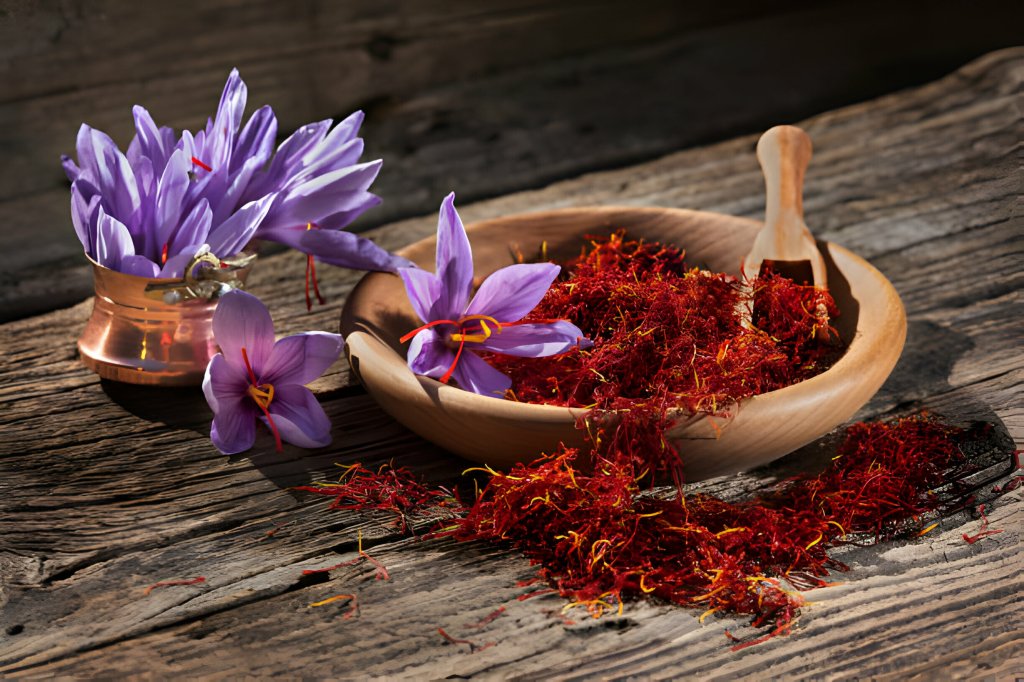Saffron, the golden-hued spice renowned for its unique flavour, vibrant colour, and myriad health benefits, holds a special place in culinary and medicinal traditions worldwide. However, the soaring demand for saffron has led to the proliferation of counterfeit products, posing a challenge for consumers seeking authenticity.
In this blog, we will explore saffron, its amazing benefits, and the complex procedure of the saffron test. We will also learn about various ways to find real Kashmiri Saffron from fake ones.
Understanding Saffron and its benefits for health
Before delving into the methods of detecting fake saffron, it’s essential to understand the characteristics of this precious spice. Saffron consists of stigma threads, hand-harvested from the Crocus sativus flower. There are three main types of saffron available in the market- Persian saffron, Kashmiri saffron and Spanish saffron. Among all these varieties of saffron, real Kashmiri kesar is regarded as the best due to its medicinal properties, aroma, and colour.
Each stigma is delicate and slender and bears a deep red colour with distinct orange-red tips. The aroma of pure saffron is intense, floral, and slightly sweet, while its taste is bitter and earthy.
The benefits of a pure saffron are as follows: –
Rich in Antioxidants
Saffron is a rich source of natural chemicals that have strong antioxidant properties, such as safranal, crocin, and crocetin. These antioxidants aid in defending the body against the oxidative damage that free radicals produce. Numerous chronic diseases, including cancer, heart problems, and neurological disorders like Alzheimer’s disease, are associated with oxidative stress. Saffron contributes to overall health by neutralising free radicals and lowering the risk of diseases of the same nature.
Improvement of Mood and Decrease of Stress
Saffron has long been valued for elevating moods. According to a research published in NCBI indicates that it could be useful in reducing anxiety and depressive symptoms. The active ingredients in saffron are thought to affect the brain’s levels of neurotransmitters, especially serotonin, which is essential for mood regulation. Regular use of saffron can help reduce stress and anxiety and maintain emotional balance by fostering feelings of well-being, relaxation, and mental clarity.
Enhances Eye Health
Studies have shown that the high concentrations of carotenoids, especially crocin, in saffron have a positive effect on eye health. These substances lessen the chance of cataracts, age-related macular degeneration (AMD), and other vision-related conditions by shielding the retina and lens from oxidative damage. Saffron may also enhance blood flow to the retina, improving vision and slowing the advancement of degenerative eye diseases.
Anti-Inflammatory Properties
Arthritis, cardiovascular conditions, and inflammatory bowel diseases are just a few illnesses linked to chronic inflammation. Because its bioactive ingredients prevent the body from producing pro-inflammatory molecules, saffron has anti-inflammatory properties.
Saffron can potentially improve joint and general health by mitigating inflammation and easing sensations like pain and stiffness linked to inflammatory disorders.
Enhances Cognitive Function
It has been demonstrated that saffron has neuroprotective properties promoting brain health and cognitive performance. According to research from NCBI states that saffron may boost neuronal activity and encourage the development of new brain cells, which may increase memory, learning, and focus.
Additionally, the antioxidant qualities of saffron shield brain tissue from oxidative stress and ageing-related deterioration, which may lessen cognitive decline and neurodegenerative illnesses like Parkinson’s and Alzheimer’s.
Including saffron in your diet or taking it as a supplement has several health advantages. These include improved mood and cognitive function, prevention of chronic illnesses, and general well-being. However, it’s important to take saffron in moderation and see a doctor, particularly if you’re taking medication or have any underlying medical conditions.
Different ways to test Detecting Fake Saffron
Saffron can be tested in far too many ways. Fake saffron is typically coated with colourant and is far less expensive than genuine saffron. The best method for determining its quality is to use one’s senses to assess the saffron’s sight, taste, and smell.
The following are the ways to test the purity of Saffron: –
Visual Inspection
Genuine saffron threads exhibit uniformity in size, length, and colour. You may notice delicate, thread-like structures with irregular edges when examined closely. On the other hand, fake saffron may appear uniform but lack the natural variations in authentic saffron threads. Look for consistency in colour and texture to identify potential adulteration.
Sensory Evaluation
The aroma and taste of saffron are critical indicators of authenticity. Gently crush a few saffron threads between your fingers and inhale deeply. Authentic saffron releases a strong, distinctive aroma characterised by floral notes and a hint of sweetness. Fake saffron may lack aroma or emit a musty odour indicative of age or poor quality. Similarly, place a small amount of saffron on your tongue. Genuine saffron imparts a bitter taste, while counterfeit saffron may taste bland or exhibit a synthetic flavour.
Water Test
Conducting a water test is a simple yet effective method to distinguish between fake and genuine saffron. Place a few saffron threads in a bowl of lukewarm water and observe the colour diffusion.
Genuine saffron will release its colour slowly, imparting a rich golden hue to the water. In contrast, fake saffron may dissolve quickly or release artificial colourants, resulting in a cloudy or unnatural water colouration.
Microscopic Examination
Under a microscope, genuine saffron threads reveal a complex structure with distinct, irregular edges. Authentic saffron exhibits a fibrous texture with visible strands and filaments. On the other hand, fake saffron may appear smoother and lack the characteristic markings of genuine saffron threads. While microscopic examination requires specialised equipment, it provides valuable insights into the authenticity of saffron.
Chemical Analysis
Advanced processes like HPLC, or high-performance liquid chromatography, can detect contaminants and verify the purity of saffron based on its chemical composition. HPLC analysis measures the concentration of crucial compounds in saffron, including crocin, picrocrocin, and safranal. While chemical analysis offers precise results, it requires access to specialised equipment and expertise.
The above-mentioned saffron tests will help you choose the best saffron for optimum benefits. You can also buy Rasayanam Kashmiri saffron, which is derived from the most fertile land of Pampore in Kashmir and has an amazing aroma, thick strands, and a deep red colour.
Conclusion
The difference between fake and real saffron is crucial for ensuring quality, authenticity, and safety in culinary and medicinal applications. By combining visual inspection, sensory evaluation, water testing, microscopic examination, and chemical analysis, consumers can confidently identify genuine saffron and avoid counterfeit products.
Whether purchasing saffron for culinary delights, traditional rituals, or health benefits, conducting a saffron test empowers consumers to make informed choices and uphold the integrity of this treasured spice.
Saffron is the most precious and the most expensive spice in the world, and out of many options, real Kashmiri saffron is the best quality saffron out there.
Commonly Asked Questions
1. What makes Kashmiri saffron unique?
A. Kashmiri saffron, grown in the fertile soils of the Kashmir Valley, is renowned for its intense flavour, aroma, and deep red colour. It contains high levels of crocin, the compound responsible for saffron’s colour, flavour, and medicinal properties.
2. Can fake saffron be harmful?
A. While fake saffron may not pose significant health risks, it lacks genuine flavour, aroma, and health benefits. Consuming adulterated saffron may also result in disappointment in culinary preparations and undermine its therapeutic effects.
3. Where can I buy authentic saffron?
A. Authentic saffron is available from reputable sources such as speciality spice stores, certified producers, and trusted online retailers. Look for saffron labelled as “pure Kashmiri saffron” or “ISO-certified” to ensure quality and authenticity.




Leave a comment